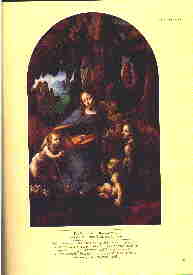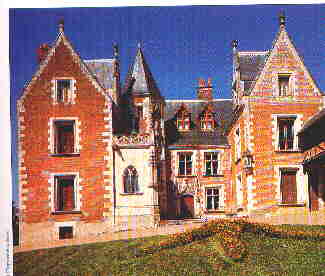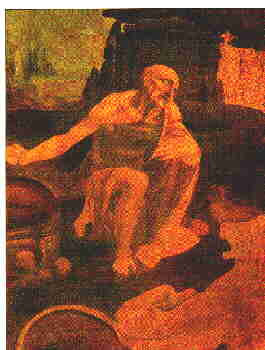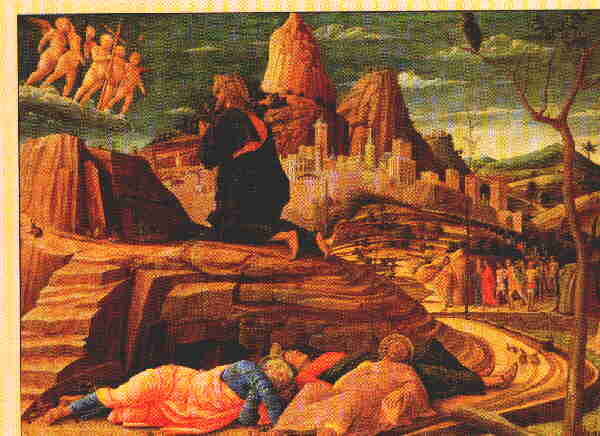 PART OF THE ARTSCHOOL
ONLINE NETWORK
PART OF THE ARTSCHOOL
ONLINE NETWORK
 THE
LIFE AND TIMES OF LEONARDO DA VINCI
THE
LIFE AND TIMES OF LEONARDO DA VINCI
Leonardo da Vinci was born on 15 April 1452 in or near
the little town of Vinci, nesting against the slopes of Monte Albano and
a day's journey from the glittering city of Florence. He was the illegitimate
son of a rising Florentine legal official, Ser Piero da Vinci. Although
little is known of Leonardo's mother, Caterina, the boy was acknowledged
cheerfully by Ser Piero and was brought up by him and Leonardo's step-mother.
Virtually nothing is known of Leonardo's childhood, though
biographers have speculated on the theme of the young Leonardo in the green
Tuscan countryside, acquiring his lifelong fascination with nature. Certainly
he began drawing and painting at an early age. According to the 16th century
artist and historian Giorgio Vasari, Leonardo's work so impressed his father
that he took samples into Florence to show to his friend Andrea del Verrocchio,
one of the leading artists of the day. Verrocchio was so enthusiastic,
and Ser Piero enrolled his teenage son in the master's busy workshop.
Verrocchio's workshop, like that of other major artists,
was something of a cross between an art school and a design studio. Apprentices
such as Leonardo worked their way up from sweeping floors to mixing colors
to helping out in the production of commissioned paintings. Leonardo had
reached this stage by the age of 20, when Verrocchio gave him responsibility
for painting one of the angels in The Baptism of Christ (c.1472)
Leonardo's angel radiated his youthful genius. Vasari
wrote that Verrocchio "never touched colours again, he was so ashamed that
the boy understood their use better than he did". Leonardo had "graduated",
and become a master of the painters' Guild of St Luke, which allowed him
to set up as an independent painter. However, he remained based at Verrocchio's
until the late 1470s.
Leonardo had learned a good deal, in the years that he
spent at his master's studio, and not all of it from Verrocchio. Florence
in the 15th century was one of the great culture centers of the world,
and Leonardo would have come in contact with many of the scholars whose
new ideas and learning were shaping the intellectual climate of Renaissance
Italy. Most importantly of all, he would have known the renowned mathematician,
geographer and astronomer Paolo Toscanelli. As Florence's most celebrated
scholar, Toscanelli was sure to include among his house guests the best
and brightest passing through the city.
A DISTRUST OF SOCIETY
Somewhere about this time, Leonardo became a vegetarian.
It was one of many ways in which he seemed to distance himself from his
contemporaries. Not that he was a recluse - according to Vasari, "Leonardo's
disposition was so lovable that he commanded everyone's affection", and
there are many other accounts of his good looks and charm, as well as his
quirky sense of humor that gave him a lifelong taste for practical jokes.
Yet he always had a deep distrust of human society: "Alone you are yourself",
he wrote, "with a companion you are half yourself".
The first years of Leonardo's life as a full-fledged
artist coincided with the rise of supreme power in Florence of Lorenzo
de' Medici - il Magnifico'. He ruled the prosperous city-state with shrewd
self-interest, and like many members of his family had cultivated tastes.
Yet Leonardo received little of the lavish patronage which abounded in
Florence at the time: though he sketched obsessively, in the years he remained
in Florence after leaving Verrocchio's studio, he executed - as far as
we know - only a handful of paintings. The most important of these, The
Adoration if the Magi, was left unfinished.
Part of the reason for this surprising lack of official
work was that Leonardo, talented though he was, had probably already gained
a reputation for not delivering his commissions. Once he had solved the
problem of a composition, he tended to lose interest and was ready to move
on to the next intellectual puzzle.
But he also had more worldly things on his mind. In 1476,
he was twice accused of the crime of sodomy, though both charges were dismissed
through lack of evidence. It may well be that he was homosexual - he never
married, and later in life usually contrived to have a young man or two
about him - but it seems more likely that there was little room in his
life for sexual relationships with either men or women. He distrusted passion
of any sort other than intellectual.
And Leonardo's intellectual pursuits were widespread
to say the least. Although he despised the violent politics of Medici's
Florence, he spent a fair amount of his time in the late 1470s designing
a whole armory of murderous engines, including a primitive machine gun.
He was soon to use his ingenuity in this field in an attempt to gain favor
- and employment - from one of Medici's rivals, Ludovico Sforza, the ruthless
Duke of Milan. Around 1482, Leonardo left Florence, and traveled to this
northern city in search of work.
 His
Milanese career got off to a slow start, but in 1483 he received an important
commission from the Church of San Francesco Grande. The church's prior
may have heard of Leonardo's reluctance to complete a piece of work for
he drew up a lengthy contract which specified a seven month deadline. He
could have saved himself the trouble as the painting - The Virgin of
the Rocks - (left) was not delivered for another 25 years.
A STATUE FOR THE DUKE
While work was beginning on The Virgin of the Rocks,
Leonardo was already thinking about another - as yet only imagined - work
of art. He knew that Duke Ludovico intended to honor his brigand father
with a massive equestrian statue, and was determined to gain the commission.
He sent the Duke an extraordinary letter in which he outlined his prowess
as a military inventor and engineer. Among other startling claims, he declared
that he could make bridges that were "indestructible by fire and battle",
and "chariots, safe and unassailable". Almost as an afterthought, he offered
his services as an architect, a sculptor and a painter.
His
Milanese career got off to a slow start, but in 1483 he received an important
commission from the Church of San Francesco Grande. The church's prior
may have heard of Leonardo's reluctance to complete a piece of work for
he drew up a lengthy contract which specified a seven month deadline. He
could have saved himself the trouble as the painting - The Virgin of
the Rocks - (left) was not delivered for another 25 years.
A STATUE FOR THE DUKE
While work was beginning on The Virgin of the Rocks,
Leonardo was already thinking about another - as yet only imagined - work
of art. He knew that Duke Ludovico intended to honor his brigand father
with a massive equestrian statue, and was determined to gain the commission.
He sent the Duke an extraordinary letter in which he outlined his prowess
as a military inventor and engineer. Among other startling claims, he declared
that he could make bridges that were "indestructible by fire and battle",
and "chariots, safe and unassailable". Almost as an afterthought, he offered
his services as an architect, a sculptor and a painter.
Leonardo's opportuneness had the desired effect. In 1483,
he was allowed to begin work on the Great Horse. His projected statue was
an immense undertaking. Innovative as always, Leonardo was unwilling to
produce the usual static sculpture: he set himself the seemingly impossible
task of creating a 26 feet high rearing horse. Such a feat had never been
achieved before, and much time was needed to solve the problem
But Ludovico Sforza was not a patient man, and by 1489
he was writing to Florence in search of another sculptor who could get
the work done more quickly. Meanwhile, Leonardo made himself a kind of
Master of Revels at the Duke's court, designing stage machinery and amusing
mechanical toys. When no sculptor could be found to take on the Great Horse
project, Leonardo was authorized to resume work on it. By November 1493,
the full-sized clay model was complete. All that was needed was for Sforza
to assemble the 90-odd tons of bronze required for its casting.
While he was waiting on the bronze, Leonardo began work
on a huge mural of The Last Supper for the nearby monastery church
of Santa Maria delle Grazie. Its brilliance was indisputable, and even
before it was finished, it drew many admiring pilgrims to the monastery.
But Leonardo had used a disastrously experimental technique and within
a few years his masterpiece was peeling off the damp wall of the monastery's
refectory.
SUCCESS AND ADMIRATION
At the time though, neither Leonardo nor his contemporaries
knew what lay in store. At 42, he was at the peak of his career, admired
and respected by all. He had his own school of apprentices, and had never
been busier. Perhaps he fretted when he heard that Ludovico had sent the
bronze once destined for the Great Horse to his embattled brither-in-law
to make cannons. But there were brighter things to think of.
He had acquired a protégé - a young boy
"with lovely hair and lovely curls and well shaped eyes and mouth", known
as Salai. And he was writing his Treatise on Painting, a huge work
which was to influence artists for centuries to come.
Leonardo's notebooks were filling rapidly, crammed with
sketches and comments written in his precise, left-to-right, mirror image
hand. He could see nothing without wanting to study it: birds, plants,
the movement of water. Above all, he became passionately interested in
human anatomy, and increasingly involved with the grim but fascinating
business of dissection. And what did not exist to be observed, he could
imagine. During these years came the first flood of inventions - a submarine,
a tank, even a helicopter.
Leonardo continued to shower his patron with grandiose
proposals for great works of architecture and civil engineering. He took
up town planning, and produced a massive scheme for the rebuilding of all
Milan, with airy boulevards and an impeccable sewage system. But Ludovico
was rarely interested: by the end of the century, he was struggling to
keep control of the city. In 1499, Milan fell to Louis XII of France.
With Ludovico and his court gone, there was nothing to
keep Leonardo in Milan, and he left the city. But he had stayed just long
enough to see the entry of Louis's army, and the destruction of a personal
dream. For during a week of drunken plunder, the French archers had found
his huge clay model, and used it for target practice. His Great Horse was
in ruins.
Accompanied by Salai, now a young man of about 20, Leonardo
traveled east to Venice. He stayed only a few months, and soon turned his
steps southwards to Florence, the home he had not seen for 18 years. In
the interim, his reputation had rocketed, and he was received with respect,
but it seems that he was not ready to settle in Florence. In 1502 he left
the city, enlisting in the service of the infamous Cesare Borgia.
BORGIA'S MILITARY ENGINEER
For Borgia was engaged in conquests in central Italy, and
he needed a military engineer. Leonardo was the perfect choice - for apart
from being the best brain in Italy, his respectability and renown would
lend some credibility to Cesare's treacherous court. So for a few months
in 1502-3, Leonardo wandered around Italy inspecting fortifications - and
then suddenly shrugged off his connection with Borgia. He returned to Florence
to live as an artist again.
It was a productive period for Leonardo. Around this
time he produced the most celebrated of all his works - the Mona Lisa.
But the other major work of this period turned out to be another technical
disaster. In 1503, the government of Florence commissioned him to paint
an epic picture of The Battle of Anghiari, to glorify an encounter
in a war with Milan some 60 years before. As with The Last Supper,
Leonardo used an experimental technique, the ruinous effects of which soon
became obvious. The Florentines demanded that he either repair the painting
or refund the payments they had made.
Typically, Leonardo ignored the demands. He was living
in his villa in nearby Fiesole, drawing and sketching industriously, and
was only rescued from some sort of legal action by the arrival of a gracious
summons from the French Viceroy in Milan, Charles d'Amboise.
D'Amboise had no authority in the Florentine Republic,
but the city had enemies enough without making more. So the Florentines
parted with the artist, who was rapturously received in Milan. Anatomy
became Leonardo's ruling passion once more: he was certain that his work
would be of lasting benefit to humanity, and pushed himself accordingly.
But his life was not all work. In 1508, he found himself
another protégé, a handsome young man named Francesco Melzi,
whom he went so far as to adopt as his son. Perhaps, if it had been up
to Leonardo, he would have passed the remainder of his life in Milan. But
in 1512 an improbable alliance between the Swiss, the Spaniards, the Venetians
and the papacy contrived to expel the French from Milan and install as
Duke the son of Ludovico Sforza. Leonardo's comfortable world at the Viceroy's
court had been shattered. At 61 years of age, he packed up his belongings,
and - accompanied by Salai and Melzi - set off for Rome.
A new pope had just been elected - Leo X, the son of
Lorenzo de' Medici. Leonardo had some hopes of exciting new commissions,
and appears to have been in good spirits at first. But the pope had little
time for him: Leonardo was yesterday's man now, with a string of uncompleted
works and grandiose failures behind him. So when Francis I, successor to
Louis XII of France, offered him a gentler oblivion as an honored pensioner
in a manor house close to the royal palace at Amboise, Leonardo accepted
and moved to France.
Ageing, frail, and with his left hand partially paralyzed
by a stroke, Leonardo fussed over his manuscripts, preparing them in a
half-hearted way for publication. In one of his notebooks he had written:
"As a well spent day brings happy sleep, so life well used brings happy
death". And quietly, on May 2 1519, a few weeks after his 67th birthday,
Leonardo da Vinci died. The world had lost perhaps its most universal genius.

RETIREMENT IN FRANCE; (left) Leonardo spent his final
years in the manor house of Clos-Luce in the Loire valley. The house is
now a Leonardo museum.

ST JEROME (c.1480) (right) It is not known for whom Leonardo
painted this picture or why he left it unfinished. Leonardo's understanding
of anatomy shows clearly in the thoroughly convincing portrayal of the
ascetic saint's sinewy body.
 ANDREA MANTEGNA (c.1430-1506) THE AGONY IN THE GARDEN:
(above) Mantegna depicts Christ in anguish as he prays in the Garden of
Gethsemane during the night before his Crucifixion. The sharp edged rocks
create emotional tension.
LEONARDO'S PAINTINGS
ANDREA MANTEGNA (c.1430-1506) THE AGONY IN THE GARDEN:
(above) Mantegna depicts Christ in anguish as he prays in the Garden of
Gethsemane during the night before his Crucifixion. The sharp edged rocks
create emotional tension.
LEONARDO'S PAINTINGS
BACK TO START PAGE
 THE
LIFE AND TIMES OF LEONARDO DA VINCI
THE
LIFE AND TIMES OF LEONARDO DA VINCI
 His
Milanese career got off to a slow start, but in 1483 he received an important
commission from the Church of San Francesco Grande. The church's prior
may have heard of Leonardo's reluctance to complete a piece of work for
he drew up a lengthy contract which specified a seven month deadline. He
could have saved himself the trouble as the painting - The Virgin of
the Rocks - (left) was not delivered for another 25 years.
His
Milanese career got off to a slow start, but in 1483 he received an important
commission from the Church of San Francesco Grande. The church's prior
may have heard of Leonardo's reluctance to complete a piece of work for
he drew up a lengthy contract which specified a seven month deadline. He
could have saved himself the trouble as the painting - The Virgin of
the Rocks - (left) was not delivered for another 25 years.


